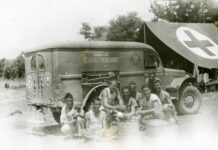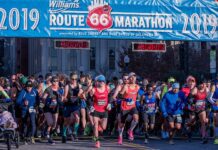Author Carmen Fields prefaces Going Back to T-Town, a fine new book about her Tulsa-based band leading father, Ernie Fields, with lyrics from a well-known song written by another musical Oklahoman, Elk City native Jimmy Webb. The lines, from the Webb composition “Didn’t We,” are all about trying and not quite succeeding, ending with the question, “Didn’t we almost make it this time?”
Although “Didn’t We” is a love song, Carmen Fields chose those lyrics to reflect something else: the whole idea of “making it” as a performer.
“However you measure ‘making it,’ being a big name, a recognizable name throughout the country – he didn’t make it in that sense,” she says of her dad. “He had some close calls. He got the chance to go to New York City, but he was impatient about making the big time and didn’t stay as long as he could have or should have. He was proud of his accomplishments, but he never achieved the level of Duke Ellington, Count Basie or Cab Calloway.”
Yet, throughout his decades as a bandleader and trombonist, Ernie Fields at least carried on a serious, long-term flirtation with music-business stardom. He toured throughout the country, especially early in his career, headlining at many venues and providing a decent living not only for himself but for his band members as well. His music was noticed by critics and industry insiders, with a number of stories and mentions of the Ernie Fields Orchestra seeing print in local and national publications, especially during the 1940s. And he not only recorded periodically for a number of labels; he also had a big hit record later in his career: a rockin’ version of the big-band standard “In the Mood,” which made it all the way up to the No. 4 spot on Billboard magazine’s Hot 100 in late 1959. It earned him a gold record (signifying sales of more than 500,000).
On top of all of that, he may have been the first person ever to lead an integrated orchestra.
“He insisted that he was, and Mother thought so as well,” says Carmen. “But all I could find on Dave Duncan was information from things like the census and the city directories; I couldn’t get a lead on anyone to verify that.”
She does know that in early 1928, her father, who was Black, hired Duncan, a white musician and arranger from Ponca City, as a member of the Ernie Fields Orchestra. It was a revolutionary and potentially dangerous move in those Jim Crow days, especially for a band that regularly toured in the South. According to the book, Fields told him that if it was ever necessary, Duncan could say he was the group’s manager.
Going Back to T-Town is full of revelations like that, eschewing a strictly chronological narrative in favor of one that focuses on the group and its members from the very beginning. This was, the author assures us, intentional.
“I’ve had people ask why I didn’t start with his being born and all of that,” she recalls. “I very purposefully wrote it the way I did because I wanted the arc of his story to start with his discovery by [famed record producer] John Hammond and end with his biggest triumph, ‘In the Mood.’
“I was conscious of the fact that I didn’t want it to be like a doctoral dissertation. That comes from my journalistic background. I wanted to tell a story, and I wanted to anchor the stories in the book, wherever possible, in actual events, which is why I used a lot of newspaper accounts and things like that.”
Carmen Fields went from writing and editing for the Boston Globe to a position as news anchor on Boston’s WGBH-TV. Later, she got into television production and scriptwriting; the 1993 PBS American Experience documentary she wrote about the Greenwood race massacre was also called “Going Back to T-Town” – a line from one of her father’s earliest recordings, 1939’s “T-Town Blues.”
“I would say I’ve been working on the book, on and off, for over 30 years,” she notes. “My father [who died in 1997] was still alive when we started talking about it, and he was very excited and engaged.
“I think the light bulb really went off in my head when the musicians who’d been in his band started dropping like flies. There were a good dozen of them I would’ve liked to have looked in the eye and have them confirm or deny the stories I’d heard – and maybe add new ones.
“The actual writing of the book,” she concludes, “happened during the pandemic; that’s when I no longer had the excuse that I didn’t have the time to get it done.”
Going Back to T-Town combines her father’s memories with reminiscences from many of his band members, along with the newspaper and magazine references she mentions. And, as she dug deeper and deeper into her father’s musical past, she says, “I was surprised by the number of musicians in his band who became famous or had careers in their own right. Before, I’d had no sense of that; I’d just seen them as boys in the band. So I gained a particular respect and even awe for the work that my father did in melding these often talented and brilliant people, with all kinds of problems and personalities, into a great organization.”
The book includes an annotated list of personnel from the Fields bands, and those interested in jazz, blues and big-band-era music will find such familiar names as trumpeter Miles Davis, saxophonist Earl Bostic, trombonist J.J. Johnson and Freddie Green, who left Fields to start his near half-century as Count Basie’s guitarist. Familiar Tulsa-based musicians who appear in the book include Tulsa Sound pioneers Rick Eilerts, Leon Rollerson and Mike Bruce; Ernie Fields’ son (and Carmen’s brother) Ernie Jr., who worked years with his dad before becoming a top music-business figure on the West Coast; and two of T-Town’s top musical legends, Western-swing innovator Bob Wills and impresario Jim Halsey.
“I don’t know how he and Bob Wills met, but for whatever reason, they clicked,” says Carmen. “Bob Wills gave him advice on booking strategies and opened a lot of doors for him.
“Jim Halsey was still in college when he started booking Dad. They just bonded. Even after Dad was no longer leading bands, they continued to collaborate on booking. He was the one who advised Dad to have both a Tulsa and California address on his letterhead, and he did that right up until the end.”
While Ernie Fields was one of the first bandleaders to integrate his orchestra, he was also one of the last – if not the last – of Oklahoma’s so-called “territory” outfits, big-band-styled groups that spent much if not most of their time playing in and around only a few states. After his rivals had given up, he kept the Fields Orchestra going, Carmen says, “through sheer will and business sense. I can remember him getting up and saying, ‘Let’s see …where can I go find me some money today?’” She laughs. “He was a business strategist to the very end.”
Carmen Fields plans to introduce the book at three different events in June. The first is set for June 15 in Oklahoma City, as a part of the Oklahoma Historical Society’s Juneteenth celebration. The second and third are both scheduled for June 17: From 1-4 p.m. at the First Baptist Church North Tulsa, 1414 W. Greenwood Ave., and later that evening at the Oklahoma Blues Hall of Fame in Rentiesville. The latter two are presented in conjunction with Tulsa’s Magic City Books.
Image cutline: Pictured is the group talent scout John Hammond and agent Willard Alexander heard circa 1940. Photo courtesy the University of Oklahoma Press





















